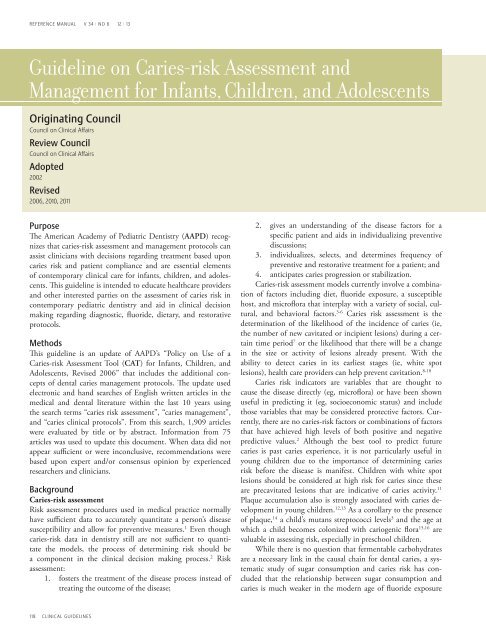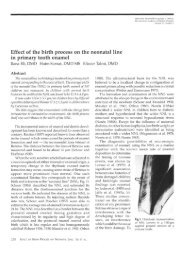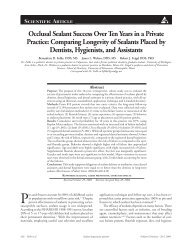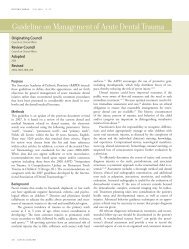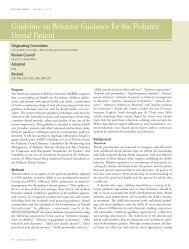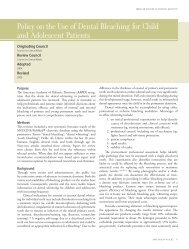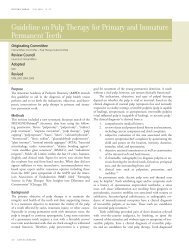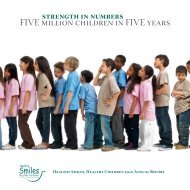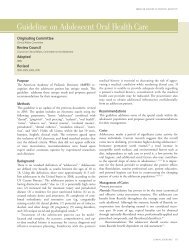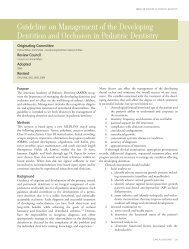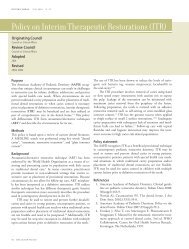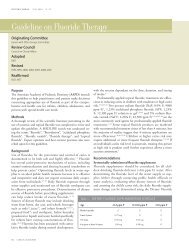Guideline on Caries-risk Assessment and Management for Infants ...
Guideline on Caries-risk Assessment and Management for Infants ...
Guideline on Caries-risk Assessment and Management for Infants ...
Create successful ePaper yourself
Turn your PDF publications into a flip-book with our unique Google optimized e-Paper software.
REFERENCE MANUAL V 34 / NO 6 12 / 13<br />
<str<strong>on</strong>g>Guideline</str<strong>on</strong>g> <strong>on</strong> <strong>Caries</strong>-<strong>risk</strong> <strong>Assessment</strong> <strong>and</strong><br />
<strong>Management</strong> <strong>for</strong> <strong>Infants</strong>, Children, <strong>and</strong> Adolescents<br />
Originating Council<br />
Council <strong>on</strong> Clinical Affairs<br />
Review Council<br />
Council <strong>on</strong> Clinical Affairs<br />
Adopted<br />
2002<br />
Revised<br />
2006, 2010, 2011<br />
Purpose<br />
The American Academy of Pediatric Dentistry (AAPD) recognizes<br />
that caries-<strong>risk</strong> assessment <strong>and</strong> management protocols can<br />
assist clinicians with decisi<strong>on</strong>s regarding treatment based up<strong>on</strong><br />
caries <strong>risk</strong> <strong>and</strong> patient compliance <strong>and</strong> are essential elements<br />
of c<strong>on</strong>temporary clinical care <strong>for</strong> infants, children, <strong>and</strong> adolescents.<br />
This guideline is intended to educate healthcare providers<br />
<strong>and</strong> other interested parties <strong>on</strong> the assessment of caries <strong>risk</strong> in<br />
c<strong>on</strong>temporary pediatric dentistry <strong>and</strong> aid in clinical decisi<strong>on</strong><br />
making regarding diagnostic, fluoride, dietary, <strong>and</strong> restorative<br />
protocols.<br />
Methods<br />
This guideline is an update of AAPD’s “Policy <strong>on</strong> Use of a<br />
<strong>Caries</strong>-<strong>risk</strong> <strong>Assessment</strong> Tool (CAT) <strong>for</strong> <strong>Infants</strong>, Children, <strong>and</strong><br />
Adolescents, Revised 2006” that includes the additi<strong>on</strong>al c<strong>on</strong>-<br />
cepts of dental caries management protocols. The update used<br />
electr<strong>on</strong>ic <strong>and</strong> h<strong>and</strong> searches of English written articles in the<br />
medical <strong>and</strong> dental literature within the last 10 years using<br />
the search terms “caries <strong>risk</strong> assessment”, “caries management”,<br />
<strong>and</strong> “caries clinical protocols”. From this search, 1,909 articles<br />
were evaluated by title or by abstract. In<strong>for</strong>mati<strong>on</strong> from 75<br />
articles was used to update this document. When data did not<br />
appear sufficient or were inc<strong>on</strong>clusive, recommendati<strong>on</strong>s were<br />
based up<strong>on</strong> expert <strong>and</strong>/or c<strong>on</strong>sensus opini<strong>on</strong> by experienced<br />
researchers <strong>and</strong> clinicians.<br />
Background<br />
<strong>Caries</strong>-<strong>risk</strong> assessment<br />
Risk assessment procedures used in medical practice normally<br />
have sufficient data to accurately quantitate a pers<strong>on</strong>’s disease<br />
susceptibility <strong>and</strong> allow <strong>for</strong> preventive measures. 1 Even though<br />
caries-<strong>risk</strong> data in dentistry still are not sufficient to quanti-<br />
tate the models, the process of determining <strong>risk</strong> should be<br />
a comp<strong>on</strong>ent in the clinical decisi<strong>on</strong> making process. 2 Risk<br />
assessment:<br />
1. fosters the treatment of the disease process instead of<br />
treating the outcome of the disease;<br />
118 CLINICAL GUIDELINES<br />
2. gives an underst<strong>and</strong>ing of the disease factors <strong>for</strong> a<br />
specific patient <strong>and</strong> aids in individualizing preventive<br />
discussi<strong>on</strong>s;<br />
3. individualizes, selects, <strong>and</strong> determines frequency of<br />
preventive <strong>and</strong> restorative treatment <strong>for</strong> a patient; <strong>and</strong><br />
4. anticipates caries progressi<strong>on</strong> or stabilizati<strong>on</strong>.<br />
<strong>Caries</strong>-<strong>risk</strong> assessment models currently involve a combinati<strong>on</strong><br />
of factors including diet, fluoride exposure, a susceptible<br />
host, <strong>and</strong> microflora that interplay with a variety of social, cul-<br />
tural, <strong>and</strong> behavioral factors. 3-6 <strong>Caries</strong> <strong>risk</strong> assessment is the<br />
determinati<strong>on</strong> of the likelihood of the incidence of caries (ie,<br />
the number of new cavitated or incipient lesi<strong>on</strong>s) during a cer-<br />
tain time period 7 or the likelihood that there will be a change<br />
in the size or activity of lesi<strong>on</strong>s already present. With the<br />
ability to detect caries in its earliest stages (ie, white spot<br />
lesi<strong>on</strong>s), health care providers can help prevent cavitati<strong>on</strong>. 8-10<br />
<strong>Caries</strong> <strong>risk</strong> indicators are variables that are thought to<br />
cause the disease directly (eg, microflora) or have been shown<br />
useful in predicting it (eg, socioec<strong>on</strong>omic status) <strong>and</strong> include<br />
those variables that may be c<strong>on</strong>sidered protective factors. Cur-<br />
rently, there are no caries-<strong>risk</strong> factors or combinati<strong>on</strong>s of factors<br />
that have achieved high levels of both positive <strong>and</strong> negative<br />
predictive values. 2 Although the best tool to predict future<br />
caries is past caries experience, it is not particularly useful in<br />
young children due to the importance of determining caries<br />
<strong>risk</strong> be<strong>for</strong>e the disease is manifest. Children with white spot<br />
lesi<strong>on</strong>s should be c<strong>on</strong>sidered at high <strong>risk</strong> <strong>for</strong> caries since these<br />
are precavitated lesi<strong>on</strong>s that are indicative of caries activity. 11<br />
Plaque accumulati<strong>on</strong> also is str<strong>on</strong>gly associated with caries de-<br />
velopment in young children. 12,13 As a corollary to the presence<br />
of plaque, 14 a child’s mutans streptococci levels 3 <strong>and</strong> the age at<br />
which a child becomes col<strong>on</strong>ized with cariogenic flora 15,16 are<br />
valuable in assessing <strong>risk</strong>, especially in preschool children.<br />
While there is no questi<strong>on</strong> that fermentable carbohydrates<br />
are a necessary link in the causal chain <strong>for</strong> dental caries, a sys-<br />
tematic study of sugar c<strong>on</strong>sumpti<strong>on</strong> <strong>and</strong> caries <strong>risk</strong> has c<strong>on</strong>-<br />
cluded that the relati<strong>on</strong>ship between sugar c<strong>on</strong>sumpti<strong>on</strong> <strong>and</strong><br />
caries is much weaker in the modern age of fluoride exposure
than previously thought. 17 However, there is evidence that<br />
night-time use of the bottle, especially when it is prol<strong>on</strong>ged,<br />
may be associated with early childhood caries. 18 Despite the fact<br />
that normal salivary flow is an extremely important intrinsic<br />
host factor providing protecti<strong>on</strong> against caries, there is little<br />
data about the prevalence of low salivary flow in children. 19,20<br />
Sociodemographic factors have been studied extensively to<br />
determine their effect <strong>on</strong> caries <strong>risk</strong>. Children with immigrant<br />
backgrounds have 3 times higher caries rates than n<strong>on</strong>-<br />
immigrants. 21 Most c<strong>on</strong>sistently, an inverse relati<strong>on</strong>ship between<br />
socioec<strong>on</strong>omic status <strong>and</strong> caries prevalence is found in studies<br />
of children less than 6 years of age. 22 Perhaps another type of<br />
sociodemographic variable is the parents’ history of cavities<br />
<strong>and</strong> abscessed teeth; this has been found to be a predictor of<br />
treatment <strong>for</strong> early childhood caries. 23,24<br />
The most studied factors that are protective of dental ca-<br />
ries include systemic <strong>and</strong> topical fluoride, sugar substitutes, <strong>and</strong><br />
tooth brushing with fluoridated toothpaste. Teeth of children<br />
who reside in a fluoridated community have been shown to<br />
have higher fluoride c<strong>on</strong>tent than those of children who reside<br />
in suboptimal fluoridated communities. 25 Additi<strong>on</strong>ally, both<br />
pre- <strong>and</strong> post-erupti<strong>on</strong> fluoride exposure maximize the caries-<br />
preventive effects. 26,27 For individuals residing in n<strong>on</strong>-fluoridated<br />
communities, fluoride supplements have shown a significant<br />
caries reducti<strong>on</strong> in primary <strong>and</strong> permanent teeth. 28 With regard<br />
to fluoridated toothpaste, studies have shown c<strong>on</strong>sistent re-<br />
ducti<strong>on</strong> in caries experience. 29 Professi<strong>on</strong>al topical fluoride<br />
Table 1. <strong>Caries</strong>-<strong>risk</strong> <strong>Assessment</strong> Form <strong>for</strong> 0-3 Year Olds 59,60<br />
(For Physicians <strong>and</strong> Other N<strong>on</strong>-Dental Health Care Providers)<br />
AMERICAN ACADEMY OF PEDIATRIC DENTISTRY<br />
applicati<strong>on</strong>s per<strong>for</strong>med semiannually also reduce caries, 30 <strong>and</strong><br />
fluoride varnishes generally are equal to that of other professi<strong>on</strong>al<br />
topical fluoride vehicles. 31<br />
The effect of sugar substitutes <strong>on</strong> caries rates have been<br />
evaluated in several populati<strong>on</strong>s with high caries prevalence. 32<br />
Studies indicate that xylitol can decrease mutans streptococci<br />
levels in plaque <strong>and</strong> saliva <strong>and</strong> can reduce dental caries<br />
in young children <strong>and</strong> adults, including children via their<br />
mothers. 33 With regard to toothbrushing, there <strong>on</strong>ly is a weak<br />
relati<strong>on</strong>ship between frequency of brushing <strong>and</strong> decreased<br />
dental caries, which is c<strong>on</strong>founded because it is difficult to<br />
distinguish whether the effect is actually a measure of fluoride<br />
applicati<strong>on</strong> or whether it is a result of mechanical removal of<br />
plaque. 34 The dental home or regular periodic care by the same<br />
practiti<strong>on</strong>er is included in many caries-<strong>risk</strong> assessment models<br />
because of its known benefit <strong>for</strong> dental health. 35<br />
Risk assessment tools can aid in the identificati<strong>on</strong> of re-<br />
liable predictors <strong>and</strong> allow dental practiti<strong>on</strong>ers, physicians, <strong>and</strong><br />
other n<strong>on</strong>dental health care providers to become more active-<br />
ly involved in identifying <strong>and</strong> referring high-<strong>risk</strong> children.<br />
Tables 1, 2, <strong>and</strong> 3 incorporate available evidence into practical<br />
tools to assist dental practiti<strong>on</strong>ers, physicians, <strong>and</strong> other n<strong>on</strong>-<br />
dental health care providers in assessing levels of <strong>risk</strong> <strong>for</strong> caries<br />
development in infants, children, <strong>and</strong> adolescents. As new evi-<br />
dence emergences, these tools can be refined to provide greater<br />
predictably of caries in children prior to disease initiati<strong>on</strong>.<br />
Furthermore, the evoluti<strong>on</strong> of caries-<strong>risk</strong> assessment tools <strong>and</strong><br />
Factors High Risk Moderate Risk Protective<br />
Biological<br />
Mother/primary caregiver has active cavities Yes<br />
Parent/caregiver has low socioec<strong>on</strong>omic status Yes<br />
Child has >3 between meal sugar-c<strong>on</strong>taining snacks or beverages per day Yes<br />
Child is put to bed with a bottle c<strong>on</strong>taining natural or added sugar Yes<br />
Child has special health care needs Yes<br />
Child is a recent immigrant Yes<br />
Protective<br />
Child receives optimally-fluoridated drinking water or fluoride supplements Yes<br />
Child has teeth brushed daily with fluoridated toothpaste Yes<br />
Child receives topical fluoride from health professi<strong>on</strong>al Yes<br />
Child has dental home/regular dental care Yes<br />
Clinical Findings<br />
Child has white spot lesi<strong>on</strong>s or enamel defects Yes<br />
Child has visible cavities or fillings Yes<br />
Child has plaque <strong>on</strong> teeth Yes<br />
Circling those c<strong>on</strong>diti<strong>on</strong>s that apply to a specific patient helps the health care worker <strong>and</strong> parent underst<strong>and</strong> the factors that c<strong>on</strong>tribute<br />
to or protect from caries. Risk assessment categorizati<strong>on</strong> of low, moderate, or high is based <strong>on</strong> prep<strong>on</strong>derance of factors <strong>for</strong> the<br />
individual. However, clinical judgment may justify the use of <strong>on</strong>e factor (eg, frequent exposure to sugar c<strong>on</strong>taining snacks or beverages,<br />
visible cavities) in determining overall <strong>risk</strong>.<br />
Overall assessment of the child’s dental caries <strong>risk</strong>: High � Moderate � Low �<br />
CLINICAL GUIDELINES 119
REFERENCE MANUAL V 34 / NO 6 12 / 13<br />
120 CLINICAL GUIDELINES<br />
Table 2. <strong>Caries</strong>-<strong>risk</strong> <strong>Assessment</strong> Form <strong>for</strong> 0-5 Year Olds 59,60<br />
(For Dental Providers)<br />
Factors High Risk Moderate Risk Protective<br />
Biological<br />
Mother/primary caregiver has active caries Yes<br />
Parent/caregiver has low socioec<strong>on</strong>omic status Yes<br />
Child has >3 between meal sugar-c<strong>on</strong>taining snacks or beverages per day Yes<br />
Child is put to bed with a bottle c<strong>on</strong>taining natural or added sugar Yes<br />
Child has special health care needs Yes<br />
Child is a recent immigrant Yes<br />
Protective<br />
Child receives optimally-fluoridated drinking water or fluoride supplements Yes<br />
Child has teeth brushed daily with fluoridated toothpaste Yes<br />
Child receives topical fluoride from health professi<strong>on</strong>al Yes<br />
Child has dental home/regular dental care Yes<br />
Clinical Findings<br />
Child has >1 decayed/missing/filled surfaces Yes<br />
Child has active white spot lesi<strong>on</strong>s or enamel defects Yes<br />
Child has elevated mutans streptococci levels Yes<br />
Child has plaque <strong>on</strong> teeth Yes<br />
Circling those c<strong>on</strong>diti<strong>on</strong>s that apply to a specific patient helps the practiti<strong>on</strong>er <strong>and</strong> parent underst<strong>and</strong> the factors that c<strong>on</strong>tribute to<br />
or protect from caries. Risk assessment categorizati<strong>on</strong> of low, moderate, or high is based <strong>on</strong> prep<strong>on</strong>derance of factors <strong>for</strong> the individual.<br />
However, clinical judgment may justify the use of <strong>on</strong>e factor (eg, frequent exposure to sugar-c<strong>on</strong>taining snacks or beverages, more than<br />
<strong>on</strong>e dmfs) in determining overall <strong>risk</strong>.<br />
Overall assessment of the child’s dental caries <strong>risk</strong>: High � Moderate � Low �<br />
Table 3. <strong>Caries</strong>-<strong>risk</strong> <strong>Assessment</strong> Form <strong>for</strong> >6 Years Olds 60-62<br />
(For Dental Providers)<br />
Factors High Risk Moderate Risk Protective<br />
Biological<br />
Patient is of low socioec<strong>on</strong>omic status Yes<br />
Patient has >3 between meal sugar-c<strong>on</strong>taining snacks or beverages per day Yes<br />
Patient has special health care needs Yes<br />
Patient is a recent immigrant Yes<br />
Protective<br />
Patient receives optimally-fluoridated drinking water Yes<br />
Patient brushes teeth daily with fluoridated toothpaste Yes<br />
Patient receives topical fluoride from health professi<strong>on</strong>al Yes<br />
Additi<strong>on</strong>al home measures (eg, xylitol, MI paste, antimicrobial) Yes<br />
Patient has dental home/regular dental care Yes<br />
Clinical Findings<br />
Patient has >1 interproximal lesi<strong>on</strong>s Yes<br />
Patient has active white spot lesi<strong>on</strong>s or enamel defects Yes<br />
Patient has low salivary flow Yes<br />
Patient has defective restorati<strong>on</strong>s Yes<br />
Patient wearing an intraoral appliance Yes<br />
Circling those c<strong>on</strong>diti<strong>on</strong>s that apply to a specific patient helps the practiti<strong>on</strong>er <strong>and</strong> patient/parent underst<strong>and</strong> the factors that c<strong>on</strong>tribute<br />
to or protect from caries. Risk assessment categorizati<strong>on</strong> of low, moderate, or high is based <strong>on</strong> prep<strong>on</strong>derance of factors <strong>for</strong> the individual.<br />
However, clinical judgment may justify the use of <strong>on</strong>e factor (eg, >1 interproximal lesi<strong>on</strong>s, low salivary flow) in determining overall <strong>risk</strong>.<br />
Overall assessment of the dental caries <strong>risk</strong>: High � Moderate � Low �
protocols can assist in providing evidence <strong>for</strong> <strong>and</strong> justifying<br />
periodicity of services, modificati<strong>on</strong> of third-party involvement<br />
in the delivery of dental services, <strong>and</strong> quality of care with<br />
outcomes assessment to address limited resources <strong>and</strong> work<strong>for</strong>ce<br />
issues.<br />
Risk Category Diagnostics<br />
Low <strong>risk</strong> – Recall every 6-12 m<strong>on</strong>ths<br />
– Baseline MS a<br />
Moderate <strong>risk</strong><br />
parent engaged<br />
Moderate <strong>risk</strong><br />
parent not engaged<br />
High <strong>risk</strong><br />
parent engaged<br />
High <strong>risk</strong><br />
parent not engaged<br />
AMERICAN ACADEMY OF PEDIATRIC DENTISTRY<br />
<strong>Caries</strong> management protocols<br />
Clinical management protocols are documents designed to<br />
assist in clinical decisi<strong>on</strong>-making; they provide criteria regarding<br />
diagnosis <strong>and</strong> treatment <strong>and</strong> lead to recommended courses<br />
of acti<strong>on</strong>. The protocols are based <strong>on</strong> evidence from current<br />
Table 4. Example of a <strong>Caries</strong> <strong>Management</strong> Protocol <strong>for</strong> 1-2 Year Olds<br />
– Recall every 6 m<strong>on</strong>ths<br />
– Baseline MS a<br />
– Recall every 6 m<strong>on</strong>ths<br />
– Baseline MS a<br />
– Recall every 3 m<strong>on</strong>ths<br />
– Baseline <strong>and</strong> follow<br />
up MS a<br />
– Recall every 3 m<strong>on</strong>ths<br />
– Baseline <strong>and</strong> follow<br />
up MS a<br />
Risk Category Diagnostics<br />
Low <strong>risk</strong> – Recall every 6-12 m<strong>on</strong>ths<br />
– Radiographs every<br />
12-24 m<strong>on</strong>ths<br />
– Baseline MS a<br />
Moderate <strong>risk</strong><br />
parent engaged<br />
Moderate <strong>risk</strong><br />
parent not<br />
engaged<br />
High <strong>risk</strong><br />
parent engaged<br />
High <strong>risk</strong><br />
parent not<br />
engaged<br />
Interventi<strong>on</strong>s<br />
Fluoride Diet<br />
– Twice daily brushing Counseling – Surveillance χ<br />
– Twice daily brushing with<br />
fluoridated toothpaste b<br />
– Fluoride supplements d<br />
– Professi<strong>on</strong>al topical treatment<br />
every 6 m<strong>on</strong>ths<br />
– Twice daily brushing with<br />
fluoridated toothpaste b<br />
– Professi<strong>on</strong>al topical treatment<br />
every 6 m<strong>on</strong>ths<br />
– Twice daily brushing with<br />
fluoridated toothpaste b<br />
– Fluoride supplements d<br />
– Professi<strong>on</strong>al topical treatment<br />
every 3 m<strong>on</strong>ths<br />
– Twice daily brushing with<br />
fluoridated toothpaste b<br />
– Professi<strong>on</strong>al topical treatment<br />
every 3 m<strong>on</strong>ths<br />
Restorative<br />
Counseling – Active surveillance e of<br />
incipient lesi<strong>on</strong>s<br />
Counseling,<br />
with limited<br />
expectati<strong>on</strong>s<br />
– Active surveillance e of<br />
incipient lesi<strong>on</strong>s<br />
Counseling – Active surveillance e of<br />
incipient lesi<strong>on</strong>s<br />
– Restore cavitated lesi<strong>on</strong>s<br />
with ITR f or definitive<br />
restorati<strong>on</strong>s<br />
Counseling,<br />
with limited<br />
expectati<strong>on</strong>s<br />
Table 5. Example of a <strong>Caries</strong> <strong>Management</strong> Protocol <strong>for</strong> 3-5 Year Olds<br />
– Recall every 6 m<strong>on</strong>ths<br />
– Radiographs every<br />
6-12 m<strong>on</strong>ths<br />
– Baseline MS a<br />
– Recall every 6 m<strong>on</strong>ths<br />
– Radiographs every<br />
6-12 m<strong>on</strong>ths<br />
– Baseline MS a<br />
– Recall every 3 m<strong>on</strong>ths<br />
– Radiographs every<br />
6 m<strong>on</strong>ths<br />
– Baseline <strong>and</strong> follow<br />
up MS a<br />
– Recall every 3 m<strong>on</strong>ths<br />
– Radiographs every<br />
6 m<strong>on</strong>ths<br />
– Baseline <strong>and</strong> follow<br />
up MS a<br />
Interventi<strong>on</strong>s<br />
Fluoride Diet Sealants l<br />
– Twice daily brushing with<br />
fluoridated toothpaste g<br />
– Twice daily brushing with<br />
fluoridated toothpaste g<br />
– Fluoride supplements d<br />
– Professi<strong>on</strong>al topical treatment<br />
every 6 m<strong>on</strong>ths<br />
– Twice daily brushing with<br />
fluoridated toothpaste g<br />
– Professi<strong>on</strong>al topical<br />
treatment every 6 m<strong>on</strong>ths<br />
– Brushing with 0.5% fluoride<br />
(with cauti<strong>on</strong>)<br />
– Fluoride supplements d<br />
– Professi<strong>on</strong>al topical<br />
treatment every 3 m<strong>on</strong>ths<br />
– Brushing with 0.5% fluoride<br />
(with cauti<strong>on</strong>)<br />
– Professi<strong>on</strong>al topical<br />
treatment every 3 m<strong>on</strong>ths<br />
– Active surveillance e of<br />
incipient lesi<strong>on</strong>s<br />
– Restore cavitated lesi<strong>on</strong>s<br />
with ITR f or definitive<br />
restorati<strong>on</strong>s<br />
Restorative<br />
No Yes – Surveillance χ<br />
Counseling Yes – Active surveillance e of<br />
incipient lesi<strong>on</strong>s<br />
– Restorati<strong>on</strong> of cavitated<br />
or enlarging lesi<strong>on</strong>s<br />
Counseling,<br />
with limited<br />
expectati<strong>on</strong>s<br />
Yes – Active surveillance e of<br />
incipient lesi<strong>on</strong>s<br />
– Restorati<strong>on</strong> of cavitated<br />
or enlarging lesi<strong>on</strong>s<br />
Counseling Yes – Active surveillance e of<br />
incipient lesi<strong>on</strong>s<br />
– Restorati<strong>on</strong> of cavitated<br />
or enlarging lesi<strong>on</strong>s<br />
Counseling,<br />
with limited<br />
expectati<strong>on</strong>s<br />
Yes – Restore incipient,<br />
cavitated, or enlarging<br />
lesi<strong>on</strong>s<br />
CLINICAL GUIDELINES 121
REFERENCE MANUAL V 34 / NO 6 12 / 13<br />
Risk Category Diagnostics<br />
Low <strong>risk</strong> – Recall every 6-12 m<strong>on</strong>ths<br />
– Radiographs every<br />
12-24 m<strong>on</strong>ths<br />
Moderate <strong>risk</strong><br />
patient/parent<br />
engaged<br />
Moderate <strong>risk</strong><br />
patient/parent<br />
not engaged<br />
High <strong>risk</strong><br />
patient/parent<br />
engaged<br />
High <strong>risk</strong><br />
patient/parent<br />
not engaged<br />
Legends <strong>for</strong> Tables 4-6<br />
a Salivary mutans streptococci bacterial levels. f Interim Therapeutic Restorati<strong>on</strong>. 63<br />
χ Periodic m<strong>on</strong>itoring <strong>for</strong> signs of caries progressi<strong>on</strong>. g Parental supervisi<strong>on</strong> of a “pea sized” amount of toothpaste.<br />
b Parental supervisi<strong>on</strong> of a “smear” amount of toothpaste. l Indicated <strong>for</strong> teeth with deep fissure anatomy or developmental<br />
d Need to c<strong>on</strong>sider fluoride levels in drinking water. defects.<br />
e Careful m<strong>on</strong>itoring of caries progressi<strong>on</strong> <strong>and</strong> preventi<strong>on</strong> program. μ Less c<strong>on</strong>cern about the quantity of toothpaste.<br />
peer-reviewed literature <strong>and</strong> the c<strong>on</strong>sidered judgment of expert<br />
panels, as well as clinical experience of practiti<strong>on</strong>ers. The protocols<br />
should be updated frequently as new technologies <strong>and</strong><br />
evidence develop.<br />
Historically, the management of dental caries was based<br />
<strong>on</strong> the noti<strong>on</strong> that it was a progressive disease that eventually<br />
destroyed the tooth unless there was surgical/restorative interventi<strong>on</strong>.<br />
Decisi<strong>on</strong>s <strong>for</strong> interventi<strong>on</strong> often were learned from<br />
unst<strong>and</strong>ardized dental school instructi<strong>on</strong>, <strong>and</strong> then refined by<br />
clinicians over years of practice. Little is known about the cri-<br />
teria dentists use when making decisi<strong>on</strong>s involving restorati<strong>on</strong><br />
of carious lesi<strong>on</strong>s. 36<br />
It is now known that surgical interventi<strong>on</strong> of dental caries<br />
al<strong>on</strong>e does not stop the disease process. Additi<strong>on</strong>ally, many<br />
lesi<strong>on</strong>s do not progress, <strong>and</strong> tooth restorati<strong>on</strong>s have a finite<br />
l<strong>on</strong>gevity. There<strong>for</strong>e, modern management of dental caries<br />
should be more c<strong>on</strong>servative <strong>and</strong> includes early detecti<strong>on</strong> of<br />
n<strong>on</strong>cavitated lesi<strong>on</strong>s, identificati<strong>on</strong> of an individual’s <strong>risk</strong> <strong>for</strong><br />
caries progressi<strong>on</strong>, underst<strong>and</strong>ing of the disease process <strong>for</strong><br />
that individual, <strong>and</strong> “active surveillance” to apply preventive<br />
measures <strong>and</strong> m<strong>on</strong>itor carefully <strong>for</strong> signs of arrestment or pro-<br />
gressi<strong>on</strong>.<br />
122 CLINICAL GUIDELINES<br />
Table 6. Example of a <strong>Caries</strong> <strong>Management</strong> Protocol <strong>for</strong> >6 Year-Olds<br />
– Recall every 6 m<strong>on</strong>ths<br />
– Radiographs every<br />
6-12 m<strong>on</strong>ths<br />
– Recall every 6 m<strong>on</strong>ths<br />
– Radiographs every<br />
6-12 m<strong>on</strong>ths<br />
– Recall every 3 m<strong>on</strong>ths<br />
– Radiographs every<br />
6 m<strong>on</strong>ths<br />
– Recall every 3 m<strong>on</strong>ths<br />
– Radiographs every<br />
6 m<strong>on</strong>ths<br />
Interventi<strong>on</strong>s<br />
Fluoride Diet Sealants l<br />
– Twice daily brushing with<br />
fluoridated toothpaste μ<br />
– Twice daily brushing with<br />
fluoridated toothpaste μ<br />
– Fluoride supplements d<br />
– Professi<strong>on</strong>al topical treatment<br />
every 6 m<strong>on</strong>ths<br />
– Twice daily brushing with<br />
toothpaste μ<br />
– Professi<strong>on</strong>al topical treatment<br />
every 6 m<strong>on</strong>ths<br />
– Brushing with 0.5% fluoride<br />
– Fluoride supplements d<br />
– Professi<strong>on</strong>al topical treatment<br />
every 3 m<strong>on</strong>ths<br />
– Brushing with 0.5% fluoride<br />
– Professi<strong>on</strong>al topical<br />
treatment every<br />
3 m<strong>on</strong>ths<br />
Restorative<br />
No Yes – Surveillance χ<br />
– Counseling Yes – Active surveillance e of<br />
incipient lesi<strong>on</strong>s<br />
– Restorati<strong>on</strong> of cavitated<br />
or enlarging lesi<strong>on</strong>s<br />
– Counseling,<br />
with limited<br />
expectati<strong>on</strong>s<br />
– Counseling<br />
– Xylitol<br />
– Counseling,<br />
with limited<br />
expectati<strong>on</strong>s<br />
– Xylitol<br />
Yes – Active surveillance e of<br />
incipient lesi<strong>on</strong>s<br />
– Restorati<strong>on</strong> of cavitated<br />
or enlarging lesi<strong>on</strong>s<br />
Yes – Active surveillance e of<br />
incipient lesi<strong>on</strong>s<br />
– Restorati<strong>on</strong> of cavitated<br />
or enlarging lesi<strong>on</strong>s<br />
Yes – Restore incipient,<br />
cavitated, or<br />
enlarging lesi<strong>on</strong>s<br />
<strong>Caries</strong> management protocols <strong>for</strong> children further refine<br />
the decisi<strong>on</strong>s c<strong>on</strong>cerning individualized treatment <strong>and</strong> treat-<br />
ment thresholds based <strong>on</strong> a specific patient’s <strong>risk</strong> levels, age,<br />
<strong>and</strong> compliance with preventive strategies (Tables 4, 5, 6). Such<br />
protocols should yield greater probability of success <strong>and</strong> better<br />
cost effectiveness of treatment than less st<strong>and</strong>ardized treatment.<br />
Additi<strong>on</strong>ally, caries management protocols free practiti<strong>on</strong>ers of<br />
the necessity <strong>for</strong> repetitive high level treatment decisi<strong>on</strong>s, st<strong>and</strong>ardize<br />
decisi<strong>on</strong> making <strong>and</strong> treatment strategies, 36-38 eliminate<br />
treatment uncertainties, <strong>and</strong> guarantee more correct strategies. 39<br />
C<strong>on</strong>tent of the present caries management protocol is<br />
based <strong>on</strong> results of clinical trials, systematic reviews, <strong>and</strong> expert<br />
panel recommendati<strong>on</strong>s that give better underst<strong>and</strong>ing of <strong>and</strong><br />
recommendati<strong>on</strong>s <strong>for</strong> diagnostic, preventive, <strong>and</strong> restorative<br />
treatments. The radiographic diagnostic guidelines are based<br />
<strong>on</strong> the latest guidelines from the American Dental Associati<strong>on</strong><br />
(ADA). 40 Systemic fluoride protocols are based <strong>on</strong> the Centers<br />
<strong>for</strong> Disease C<strong>on</strong>trol <strong>and</strong> Preventi<strong>on</strong>’s (CDC) recommendati<strong>on</strong>s<br />
<strong>for</strong> using fluoride. 29 <str<strong>on</strong>g>Guideline</str<strong>on</strong>g>s <strong>for</strong> the use of topical fluoride<br />
treatment are based <strong>on</strong> the ADA’s Council <strong>on</strong> Scientific Affairs’<br />
recommendati<strong>on</strong>s <strong>for</strong> professi<strong>on</strong>ally-applied topical fluoride, 41<br />
the Scottish Intercollegiate <str<strong>on</strong>g>Guideline</str<strong>on</strong>g> Network guideline <strong>for</strong>
the management of caries in pre-school children, 42 a Maternal<br />
<strong>and</strong> Child Health Bureau Expert Panel, 43 <strong>and</strong> the CDC’s fluoride<br />
guidelines. 29 <str<strong>on</strong>g>Guideline</str<strong>on</strong>g>s <strong>for</strong> pit <strong>and</strong> fissure sealants are<br />
based <strong>on</strong> ADA’s Council <strong>on</strong> Scientific Affairs recommendati<strong>on</strong>s<br />
<strong>for</strong> the use of pit-<strong>and</strong>-fissure sealants. 44 <str<strong>on</strong>g>Guideline</str<strong>on</strong>g>s <strong>on</strong> diet<br />
counseling to prevent caries are based <strong>on</strong> 2 review papers. 45,46<br />
<str<strong>on</strong>g>Guideline</str<strong>on</strong>g>s <strong>for</strong> the use of xylitol are based <strong>on</strong> the AAPD’s<br />
oral health policy <strong>on</strong> use of xylitol in caries preventi<strong>on</strong>, 32 a<br />
well-executed clinical trial <strong>on</strong> high caries-<strong>risk</strong> infants <strong>and</strong> tod-<br />
dlers, 47 <strong>and</strong> 2 evidence-based reviews. 48,49 Active surveillance<br />
(preventi<strong>on</strong> therapies <strong>and</strong> close m<strong>on</strong>itoring) of enamel lesi<strong>on</strong>s<br />
is based <strong>on</strong> the c<strong>on</strong>cept that treatment of disease may <strong>on</strong>ly be<br />
necessary if there is disease progressi<strong>on</strong>, 50 that caries progres-<br />
si<strong>on</strong> has diminished over recent decades, 51 <strong>and</strong> that the ma-<br />
jority of proximal lesi<strong>on</strong>s, even in dentin, are not cavitated. 52<br />
Other approaches to the assessment <strong>and</strong> treatment of<br />
dental caries will emerge with time <strong>and</strong>, with evidence of effectiveness,<br />
may be included in future guidelines <strong>on</strong> caries <strong>risk</strong><br />
assessment <strong>and</strong> management protocols. For example, there are<br />
emerging trends to use calcium <strong>and</strong> phosphate remineralizing<br />
soluti<strong>on</strong> to reverse dental caries. 53 Other fluoride compounds,<br />
such as silver diamine fluoride 54 <strong>and</strong> stannous fluoride 55 , may<br />
be more effective than sodium fluoride <strong>for</strong> topical applicati<strong>on</strong>s.<br />
There has been interest in antimicrobials to affect the caries<br />
rates, but evidence from caries trials is still inc<strong>on</strong>clusive. 56 How-<br />
ever, some other proven methods, such as prescripti<strong>on</strong> fluoride<br />
drops <strong>and</strong> tablets, may be removed from this protocol in the<br />
future due to attitudes, <strong>risk</strong>s, or compliance. 57,58<br />
Recommendati<strong>on</strong>s<br />
1. Dental-caries <strong>risk</strong> assessment, based <strong>on</strong> a child’s age, bio-<br />
logical factors, protective factors, <strong>and</strong> clinical findings,<br />
should be a routine comp<strong>on</strong>ent of new <strong>and</strong> periodic ex-<br />
aminati<strong>on</strong>s by oral health <strong>and</strong> medical providers.<br />
2. While there is not enough in<strong>for</strong>mati<strong>on</strong> at present to have<br />
quantitative caries-<strong>risk</strong> assessment analyses, estimating<br />
children at low, moderate, <strong>and</strong> high caries <strong>risk</strong> by a<br />
prep<strong>on</strong>derance of <strong>risk</strong> <strong>and</strong> protective factors will enable<br />
a more evidence-based approach to medical provider re-<br />
ferrals, as well as establish periodicity <strong>and</strong> intensity of<br />
diagnostic, preventive, <strong>and</strong> restorative services.<br />
3. Clinical management protocols, based <strong>on</strong> a child’s age,<br />
caries <strong>risk</strong>, <strong>and</strong> level of patient/parent cooperati<strong>on</strong>, provide<br />
health providers with criteria <strong>and</strong> protocols <strong>for</strong> determining<br />
the types <strong>and</strong> frequency of diagnostic, preventive,<br />
<strong>and</strong> restorative care <strong>for</strong> patient specific management of<br />
dental caries.<br />
References<br />
1. Lauer MS, F<strong>on</strong>tanarosa BP. Updated guidelines <strong>for</strong> cholesterol<br />
management. JAMA 2001;285(19):2486-97.<br />
2. Zero D, F<strong>on</strong>tana M, Lenn<strong>on</strong> AM. Clinical applicati<strong>on</strong>s<br />
<strong>and</strong> outcomes of using indicators of <strong>risk</strong> in caries man-<br />
agement. J Dent Educ 2001;65(10):1126-32.<br />
AMERICAN ACADEMY OF PEDIATRIC DENTISTRY<br />
3. Litt MD, Reisine S, Tinanoff N. Multidimensi<strong>on</strong>al causal<br />
model of dental caries development in low-income pre-<br />
school children. Public Health Reports 1995;110(4):<br />
607-17.<br />
4. Nicolau B, Marcenes W, Bartley M, Sheiham A. A life<br />
course approach to assessing causes of dental caries experience:<br />
The relati<strong>on</strong>ship between biological, behavioural,<br />
socio-ec<strong>on</strong>omic <strong>and</strong> psychological c<strong>on</strong>diti<strong>on</strong>s <strong>and</strong> caries<br />
in adolescents. <strong>Caries</strong> Res 2003;37(5):319-26.<br />
5. Featherst<strong>on</strong>e JD. The caries balance: C<strong>on</strong>tributing factors<br />
<strong>and</strong> early detecti<strong>on</strong>. J Calif Dent Assoc 2003;31(2):129-33.<br />
6. Featherst<strong>on</strong>e JD. The caries balance: The basis <strong>for</strong> caries<br />
management by <strong>risk</strong> assessment. Oral Health Prev Dent<br />
2004;2(Suppl 1):259-64.<br />
7. Reich E, Lussi A, Newbrun E. <strong>Caries</strong>-<strong>risk</strong> assessment. Int<br />
Dent J 1999;49(1):15-26.<br />
8. Ismail AI, Nainar SM, Sohn W. Children’s first dental<br />
visit: Attitudes <strong>and</strong> practices of US pediatricians <strong>and</strong> fam-<br />
ily physicians. Pediatr Dent 2003;25(5):425-30.<br />
9. Tsang P, Qi F, Shi W. Medical approach to dental caries:<br />
Fight the disease, not the lesi<strong>on</strong>. Pediatr Dent 2006;28<br />
(2):188-98.<br />
10. Crall JJ. Development <strong>and</strong> integrati<strong>on</strong> of oral health<br />
services <strong>for</strong> preschool-age children. Pediatr Dent 2005;<br />
27(4):323-30.<br />
11. Vadiakas G. Case definiti<strong>on</strong>, aetiology <strong>and</strong> <strong>risk</strong> assess-<br />
ment of early childhood caries (ECC): A revisited review.<br />
European Arch Paed Dent 2008;9(9):114-25.<br />
12. Alaluusua S, Malmivirta R. Early plaque accumulati<strong>on</strong> –<br />
A sign <strong>for</strong> caries <strong>risk</strong> in young children. Community<br />
Dent Oral Epidemiol 1994;22(10):273-6.<br />
13. Roeters J, Burgesdijk R, Truin GJ, van ’t Hof M. Dental<br />
caries <strong>and</strong> its determinants in 2- to-5-year old children.<br />
ASDC J Dent Child 1995;62(6):401-8.<br />
14. Lee C, Tinanoff N, Minah G, Romberg E. Effect of Mu-<br />
tans streptococcal col<strong>on</strong>izati<strong>on</strong> <strong>on</strong> plaque <strong>for</strong>mati<strong>on</strong> <strong>and</strong><br />
regrowth in young children – A brief communicati<strong>on</strong>. J<br />
Public Health Dent 2008;68(1):57-60.<br />
15. Thibodeau EA, O’Sullivan DM, Tinanoff N. Mutans<br />
streptococci <strong>and</strong> caries prevalence in preschool children.<br />
Community Dent Oral Epidemiol 1993;21(5):288-91.<br />
16. Grindefjord M, Dahllöf G, Nilss<strong>on</strong> B, Modéer T. Predicti<strong>on</strong><br />
of dental caries development in 1-year old children.<br />
<strong>Caries</strong> Res 1995;29(5):343-8.<br />
17. Burt BA, Satishch<strong>and</strong>ra P. The relati<strong>on</strong>ship between low<br />
birthweight <strong>and</strong> subsequent development of caries: A systematic<br />
review. J Dent Ed 2001;65(10):1017-23.<br />
18. Reisine S, Douglass JM. Psychosocial <strong>and</strong> behavioral<br />
issues in early childhood caries. Community Dent Oral<br />
Epidemiol 1998;26(1 Suppl):45-8.<br />
19. Cataldo WL, Oppenheim FG. Physical <strong>and</strong> chemical<br />
aspects of saliva as indicators of <strong>risk</strong> <strong>for</strong> dental caries in<br />
humans. J Dent Ed 2001;65(10):1054-62.<br />
CLINICAL GUIDELINES 123
REFERENCE MANUAL V 34 / NO 6 12 / 13<br />
20. Vanobbergen J, Martens L, Lesaffre E, Bogaerts K, Declerck<br />
D. The value of a baseline caries <strong>risk</strong> assessment model<br />
in the primary dentiti<strong>on</strong> <strong>for</strong> the predicti<strong>on</strong> of caries in-<br />
crement in the permanent dentiti<strong>on</strong>. <strong>Caries</strong> Res 2001;35<br />
(6):442-50.<br />
21. Nunn ME, Dietrich T, Singh HK, Henshaw MM, Kressin<br />
NR. Prevalence of early childhood caries am<strong>on</strong>g very<br />
young urban Bost<strong>on</strong> children compared with US Chil-<br />
dren. J Public Health Dent 2009;69(3):156-62.<br />
22. Vargas CM, Crall JJ, Schneider DA. Sociodemographic<br />
distributi<strong>on</strong> of pediatric dental caries: NHANES III,<br />
1988-1994. J Am Dent Assoc 1998;129(9):1229-38.<br />
23. Southward LH, Roberts<strong>on</strong> A, Edelstein BL, et al. Oral<br />
health of young children in Mississippi Delta child care<br />
centers: A sec<strong>on</strong>d look at early childhood caries <strong>risk</strong> assess-<br />
ment. J Public Health Dent 2008;68(4):188-95.<br />
24. Thitasomakul S, Piwat S, Thearm<strong>on</strong>tree A, Chankanka<br />
O, Pithpornchaiyakul W, Madyusoh S. Risks <strong>for</strong> early<br />
childhood caries analyzed by negative binomial models. J<br />
Dent Res 2009;88(2):137-41.<br />
25. Weatherell J, Deutsch D, Robins<strong>on</strong> C, Hallsworth AS.<br />
Assimilati<strong>on</strong> of fluoride by enamel throughout the life<br />
of the tooth. <strong>Caries</strong> Res 1977;11(2):85-115.<br />
26. Backer Dirks O, Houwink B, Kwant GW. The results of<br />
6½ years of artificial fluoridati<strong>on</strong> of drinking water in The<br />
Netherl<strong>and</strong>s – The Tiel Cumemborg experiment. Arch<br />
Oral Biol 1961;5(12):284-300.<br />
27. Singh KA, Spencer AJ, Armfield JM. Relative effects of<br />
pre-<strong>and</strong> post-erupti<strong>on</strong> water fluoride <strong>on</strong> caries experience<br />
of permanent first molars. J Pub Heath Dent 2003;63<br />
(1):11-9.<br />
28. Murray JJ, Naylor MN. Fluorides <strong>and</strong> dental caries. In:<br />
Murray JJ, ed. Preventi<strong>on</strong> of Oral Disease. Ox<strong>for</strong>d University<br />
Press, Ox<strong>for</strong>d; 1996:32-67.<br />
29. CDC. Recommendati<strong>on</strong>s <strong>for</strong> using fluoride to prevent<br />
<strong>and</strong> c<strong>on</strong>trol dental caries in the United States. MMWR<br />
Recomm Rep 2001;50(RR14):1-42.<br />
30. Ripa LW. A critique of topical fluoride methods (denti-<br />
frice, mouthrinses, operator-, <strong>and</strong> self-applied gels) in an<br />
era of decreased caries <strong>and</strong> increased fluorosis prevalence.<br />
J Pub Health Dent 1991;51(1):23-41.<br />
31. Beltrán-Aguilar ED, Goldstein JW, Lockwood SA. Fluoride<br />
varnishes: A review of their clinical use, cariostatic<br />
mechanism, efficacy <strong>and</strong> safety. J Am Dent Assoc 2000;<br />
131(5):589-96.<br />
32. American Academy of Pediatric Dentistry. Policy <strong>on</strong> use<br />
of xylitol in caries preventi<strong>on</strong>. Pediatr Dent 2010;32<br />
(special issue):36-8.<br />
33. Ly KA, Milgrom P, Rothen M. Xylitol, sweeteners, <strong>and</strong><br />
dental caries. Pediatr Dent 2006;28(2):154-63.<br />
34. Reisine ST, Psoter W. Socioec<strong>on</strong>omic status <strong>and</strong> selected<br />
behavioral determinants <strong>and</strong> <strong>risk</strong> factor <strong>for</strong> dental caries.<br />
J Dent Ed 2001;65(10):1009-16.<br />
35. Nowak AJ, Casamassimo PS. The dental home. A primary<br />
care oral health c<strong>on</strong>cept. J Am Dent Assoc 2002;133<br />
(1):93-8.<br />
124 CLINICAL GUIDELINES<br />
36. Bader JD, Shugars DA. What do we know about how<br />
dentists make caries-related treatment decisi<strong>on</strong>s? Community<br />
Dent Oral Epidemiol 1997;25(1):97-103.<br />
37. Anusavice K. <strong>Management</strong> of dental caries as a chr<strong>on</strong>ic<br />
infectious disease. J Dent Ed 1998;62(10):791-802.<br />
38. Benn DK, Clark TD, Dankel DD, Kostewicz SH. Prac-<br />
tical approach to evidence-based management of caries.<br />
J Am Coll Dent 1999;66(1):27-35.<br />
39. White BA, Maupome G. Clinical decisi<strong>on</strong>-making <strong>for</strong><br />
dental caries management. J Dent Ed 2001;65(10):1121-5.<br />
40. American Dental Associati<strong>on</strong> Council <strong>on</strong> Scientific Affairs.<br />
The use of dental radiographs. Update <strong>and</strong> recommendati<strong>on</strong>s.<br />
J Am Dent Assoc 2006;137(9):1304-12.<br />
41. American Dental Associati<strong>on</strong> Council <strong>on</strong> Scientific Affairs.<br />
Professi<strong>on</strong>ally applied topical fluoride: Evidence-based<br />
clinical recommendati<strong>on</strong>s. J Am Dent Assoc 2006;137<br />
(8):1151-9.<br />
42. Scottish Intercollegiate <str<strong>on</strong>g>Guideline</str<strong>on</strong>g> Network (SIGN). Pre-<br />
venti<strong>on</strong> <strong>and</strong> management of dental decay in the pre-<br />
school child. 2005. Available at: “http://www.sign.ac.uk/<br />
pdf/sign83.pdf”. Accessed July 2, 2010.<br />
43. Maternal <strong>and</strong> Child Health Bureau Expert Panel. Topical<br />
fluoride recommendati<strong>on</strong>s <strong>for</strong> high-<strong>risk</strong> children: Development<br />
of decisi<strong>on</strong> support matrix. October 22–23,<br />
2007, Altarum Institute, Washingt<strong>on</strong>, DC. Available at:<br />
“http://mohealthysmiles.typepad.com/Topical%20fl%<br />
20recommendati<strong>on</strong>s%20<strong>for</strong>%20hi%20<strong>risk</strong>%20children.<br />
pdf”. Accessed July 3, 2010.<br />
44. American Dental Associati<strong>on</strong> Council <strong>on</strong> Scientific Affairs.<br />
Evidence-based clinical recommendati<strong>on</strong>s <strong>for</strong> the use of<br />
pit-<strong>and</strong>-fissure sealants. J Am Dent Assoc 2008;139(4):<br />
257-67.<br />
45. Tinanoff N. Associati<strong>on</strong> of diet with dental caries in<br />
pre-school children. Dental Clin North Am 2005;49(4):<br />
725-7.<br />
46. Burt BA, Pai S. Sugar c<strong>on</strong>sumpti<strong>on</strong> <strong>and</strong> caries <strong>risk</strong>: A<br />
systematic review. J Dent Ed 2001;65(10):1017-23.<br />
47. Milgrom P, Ly KA, Tut OK, et al. Xylitol pediatric topical<br />
oral syrup to prevent dental caries. Arch Pediatr Adolesc<br />
Med 2009;163(7):601-7.<br />
48. Maguire A, Rugg-Gunn AJ. Xylitol <strong>and</strong> caries preventi<strong>on</strong><br />
– Is it a magic bullet? British Dent J 2003;194(8):429-36.<br />
49. Hayes C. The effect of n<strong>on</strong>-cariogenic sweeteners <strong>on</strong> the<br />
preventi<strong>on</strong> of dental caries: A review of the evidence. J<br />
Dent Ed 2001;65(10):1106-9.<br />
50. Parker C. Active surveillance: Toward a new paradigm in<br />
the management of early prostate cancer. Lancet Oncol<br />
2004;5(2):101-6.<br />
51. Warren JJ, Levy SM, Broffitt B, Kanellis MJ. L<strong>on</strong>gitudinal<br />
study of n<strong>on</strong>-cavitated carious lesi<strong>on</strong> progressi<strong>on</strong> in the<br />
primary dentiti<strong>on</strong> J Public Health Dent 2006;66(2):83-7.<br />
52. Anusavice KJ. Present <strong>and</strong> future approaches <strong>for</strong> the<br />
c<strong>on</strong>trol of caries. J Dent Ed 2005;69(5):538-54.
53. Hicks J, García-Godoy F, Flaitz C. Biological factors in<br />
dental caries: Role of remineralizati<strong>on</strong> <strong>and</strong> fluoride in the<br />
dynamic process of demineralizati<strong>on</strong> <strong>and</strong> remineraliza-<br />
ti<strong>on</strong>. J Clin Ped Dent 2004;28(1):203-14.<br />
54. Rosenblatt A, Stam<strong>for</strong>d TCM, Niederman R. Silver dia-<br />
mine fluoride: A caries “silver-fluoride bullet”. J Dent Res<br />
2009;88(2):116-25.<br />
55. Tinanoff N. Progress regarding the use of stannous fluo-<br />
ride in clinical dentistry. J Clinical Dent 1995;6(Special<br />
issue):37-40.<br />
55. Twetman S. Preventi<strong>on</strong> of early childhood caries (ECC).<br />
Review of literature published 1998-2007. Europ Archives<br />
Paed Dent 2008;9(1):12-8.<br />
56. Caufield PW, Desanayke AP, Li Y. The antimicrobial approach<br />
to caries management. J Dent Ed 2001;65(10):<br />
1091-5.<br />
57. Ismail AI, Hassen H. Fluoride supplements, dental caries<br />
<strong>and</strong> fluorosis. A systematic review. J Am Dent Assoc 2008;<br />
139(11):1457-68.<br />
58. Tinanoff N. Use of fluorides. In: Berg J, Slayt<strong>on</strong> RL, eds.<br />
Early Childhood Oral Health. Wiley-Blackwell: Ames,<br />
Iowa; 2009:92-109.<br />
AMERICAN ACADEMY OF PEDIATRIC DENTISTRY<br />
59. Ramos-Gomez FJ, Crall J, Gansky SA, Slayt<strong>on</strong> RL, Featherst<strong>on</strong>e<br />
JDB. <strong>Caries</strong> <strong>risk</strong> assessment appropriate <strong>for</strong> the<br />
age 1 visit (infants <strong>and</strong> toddlers). J Calif Dent Assoc<br />
2007;35(10):687-702.<br />
60. American Dental Associati<strong>on</strong> Councils <strong>on</strong> Scientific Affairs<br />
<strong>and</strong> Dental Practice. <strong>Caries</strong> Risk <strong>Assessment</strong> Form (Ages<br />
0-6). American Dental Associati<strong>on</strong>: Chicago, Ill; 2008.<br />
Available at: “http://www.ada.org/secti<strong>on</strong>s/professi<strong>on</strong>al<br />
Resources/docs/topics_caries_under6.doc”. Accessed July<br />
3, 2010.<br />
61. American Dental Associati<strong>on</strong> Councils <strong>on</strong> Scientific Affairs<br />
<strong>and</strong> Dental Practice. <strong>Caries</strong> Risk <strong>Assessment</strong> Form (Age >6).<br />
American Dental Associati<strong>on</strong>: Chicago, Ill; 2008. Available<br />
at: “http://www.ada.org/secti<strong>on</strong>s/professi<strong>on</strong>alResources/<br />
docs/topics_caries_over6.doc\”. Accessed July 3, 2010.<br />
62. Featherst<strong>on</strong>e JDB, Domejean-Orliaguet S, Jens<strong>on</strong> L, Wolff<br />
M, Young DA. <strong>Caries</strong> <strong>risk</strong> assessement in practice <strong>for</strong><br />
age 6 through adult. J Calif Dent Assoc 2007;35(10):<br />
703-13.<br />
63. American Academy of Pediatric Dentistry. Policy <strong>on</strong> in-<br />
terim therapeutic restorati<strong>on</strong>s. Pediatric Dent 2009;31<br />
(special issue):38-9.<br />
CLINICAL GUIDELINES 125


